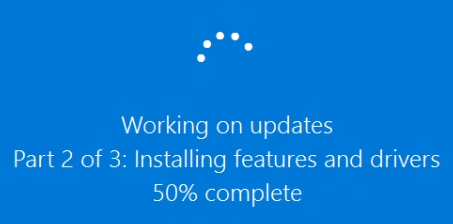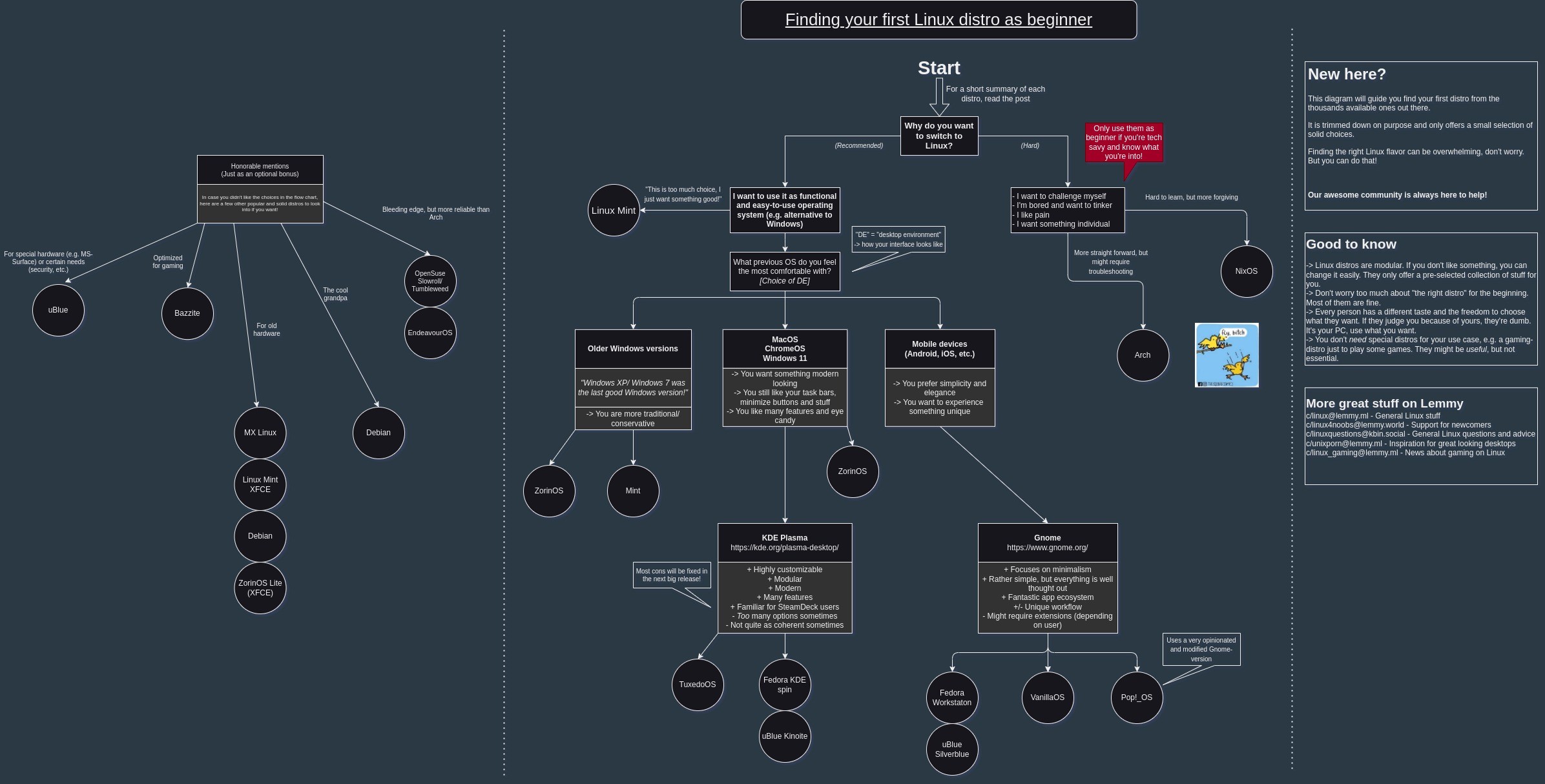I mean that only matters for people like us.
99.99% of the Windows user base doesn’t give the tiniest semblance of a shit about any of that. Hell I run Windows on my gaming pc still and have never had cause to do any of that.
what if you wanted to show a presentation but windows said 
I’m going to be honest with you, as often as this has been memed and for as long as I have been using Windows on my work computer, I have never once been forced to restart on the spot by an automatic update.
I’m sure those who have will be quick to reply but at this point I’m 90% confident it’s a loud minority.
I’ve seen an entire factory shut down for hours because two critical Win10 computers tried and failed to update. It’s never an issue until it becomes one.
Plus a failed update is the whole reason I nuked my C: drive and switched to Manjaro (now running Arch, put down the pitchforks).
Well, running Windows 10, a consumer user-oriented operating system, to control mission-critical machines is mistake number 1.
This wouldn’t have happened if they had used Windows Server or something actually designed for that task (like Linux!).
Neither of those options were available. It was written by a third-party for some old .NET Framework version, and the server and GUI components were written as a single application. Putting it on a server wasn’t an option either because the application’s GUI was constantly used for the management of assembly machines, and other applications were used for monitoring and administrative stuff.
If you had been there, you’d know why this was a low-priority risk. That place was bleeding from a thousand wounds. At least this had some redundancy, for all it was worth in the end…
(edit) I actually contributed to that software, even though it’s not open-source! I managed to nail down an issue where loading a project file using one locale would result in a crash, but not in others. The .NET stack trace was printed to an XHR response’s payload and I used that to locate a
float.ToString()call whereCurrentCulturewas passed as the cultureInfo instead ofInvariantCulture, so depending on the computer’s locale, it would try to parse CSV data either using a decimal dot or a decimal comma. I mailed this to the maintainer and the fix was released within the month.Windows Server is an option.
The operating system is called “Windows Server”. It doesn’t necessarily have to run on a mainframe. It has the regular Windows GUI (with a few differences, the first you’ll notice is “Cntr+Alt+Del to log in”) and can run regular Windows programs.
It’s more like when you shut the laptop down, then turn it on only to be greeted with such message. So, I also haven’t seen much of those back when, but only due to the unhealthy habit of maximizing uptime.
I am with you but it’s the wrong place to be discussing this.
Reserved bandwidth??
Some sort of hidden, concealed, clandestine internal QoS implementation in Windows. Reserving a portion of network bandwidth for high priority traffic sounds like a good concept, but I don’t like the fact that this is so hidden (I’ve been working with computers for many years and I’ve never heard of it until now), and that the mechanism to determine the priority of a packet is unknown.
It’s used for updates. I’m not sure if it works all the time.
I think that it used to be called
superfetchin the old days. https://answers.microsoft.com/en-us/windows/forum/all/superfetch-service-disable-helps-to-increase-speed/3c4d5b4b-edef-4eb7-9456-52fd304e606cIf you’re using an “unofficial” license, it’s probably normal to disable updates and afferent services.
I remember from years ago when I was modding Windows XP installations with nLite to try to purge all the unnecessary bits and install some useful stuff. Superfetch was this annoying service that supposedly ruined online gaming due to lag. :)
Prefetch and superfecth are just obnoxious services that waste disk space. You can safely disable them, there is no downside to not using prefetch or superfect on modern SSDs. On regular spinning drives, yes, they did make loading programs a bit faster.
Superfetch was keeping an index of file relationships in RAM and pre-loading files you were probably going to use next. It didn’t ping your network at all, but it could easily eat up a ton of disk resources and RAM. It was really only an issue on old 5400rpm laptop HDDs from what I remember.
Might be thinking of windows search indexing.
Yes, disable Windows search indexing as well. No point in having that on an SSD, it’s pointless, it just wastes disk space.
20 years ago, a friend said “Windows does whatever you don’t tell it not to do”. It is as true now as it was then.
90% of configuring Windows is disabling shit.
The reality is, for 98% plus of windows users, NONE of that matters. MS could give a shit about tech. nerds that want to de-bloat, reduce resources, install crazy niche thingyawidget…
Pretty much everyone in this community is not their target.
Car analogy! You are car guys running custom block modified street racers shitting on electric cars…
“Windows Reserved Bandwidth” is just a QoS Packet Scheduler. The Linux Kernel has this too. Equally difficult to disable on any system, because its assumed you will want to be able to download a file and surf the web at the same time. You can turn it off I guess, if quality of service isn’t your vibe.
It’s always funny seeing users doing their cargo cult dances when troubleshooting stuff
Shocked Pikachu face when other stuff starts breaking because you ‘optimised’ 500 settings
Windows Reserved Bandwidth” is just a QoS Packet Scheduler. The Linux Kernel has this too. Equally difficult to disable on any system, because its assumed you will want to be able to download a file and surf the web at the same time.
Do we know for a fact that the Windows marketing telemetry does not use any of this reserved bandwidth? Or are we just taking the vendor’s word for that?
I asked because ‘reserving’ is different than ‘prioritizing’. Generally speaking, a QoS prioritizes, where what’s being described by the title is reserving.
because it’s* assumed
Meme’s not wrong and I daily Linux, but how we got here is all that crap on the bottom has a pretty low chance of leaving you bricked and getting back from bricking windows is usually marginally trivial. The same people get lost in Linux, don’t read warnings, do stupid shit without thinking then spend forever trying to muddle through how to fix it. Mr. LTT did it himself.
If Linus is good for anything, it’s being a perfect example of the average moron who thinks they know everything so they actively refuse new information.
verage moron who thinks they know everything so they
I had such high hopes when he and Luke started that challenge. If they would have made it, we’d probably have twice the uptake we have now. But because he has to drop out to cli and do stupid crap. He could have run Ubuntu with Unfree and used straight GUI installs and have been in steam in 15 minutes.
Honestly I’ve had way more completely bricked Windows installs than Linux. Don’t think I’ve ever managed to completely Bork a Linux install except when doing something extremely stupid. I’ve had Windows get to the point where no amount of SFC of dsim could get to go boot again just by having the power go out during an update or other fairly mundane issues.
ore completely bricked Windows installs than Linux. Don’t think I’ve ever managed to completely Bork a Linux install ex Everybody has different experiences.
I completely shattered my NixOS install by trying to activate Nvidia Prime on my laptop. Of course it was NixOS, so i could roll back from the boot loader. There was the time I used vim to edit /etc/sudoers on a remote VM. that was a joy.
If you screw up most of your core windows install DISM online cleanup will put most of it back.
Windows has more guard rails than say Debian or Ubuntu. But to each their own.
I mean you can remove all remote admin rights on Windows too haha, remote gives you way more opportunities screw stuff up.
But usually on Linux you can boot in single user or chroot in from the installer and unhose whatever you hosed. Windows you get dism and SFC and if they don’t work there’s really not anything you can do.
OP never watched the LTT Linux video
Edit: for people that also haven’t watched it: Linus tried to use Pop-OS for gaming. When he tried to install Steam it uninstalled his desktop-environment leaving him with only a terminal.
it did warn him to be fair. he had to type out “yes, do as i say”, which is a HUGE red flag. even to me, a farely casual windows user.
It was hidden in a massive wall of text. Ain’t nobody got time for that
Man was installing Steam why does it even want to remove his desktop environment to begin with.
Just watched that portion. When he scrolls down to “yes do as I say” you can literally see two lines above it stating it will remove desktop environment.
Outputs exist for a reason, folks.
And that is why Linux isn’t as widely distributed as Windows. Linux is great, if you know what you are doing. But most of the world doesn’t have the time needed to learn Linux well enough to avoid major fuck-ups like this.
Linux gives you a wall of text when all the user did (at least what they thought they did) is say install this program. The system ask “Are you sure?” And the user is like “Yes, just do it!” I can’t imagine anything on Windows doing that lol.
I like Linux and I think it’s great, but I can certainly understand why the majority of people are wary of it.
To play devils advocate, I’d say that the bigger issue is that Linus ended up in the terminal to start with, when he had no idea what he was doing in there.
If Linux is to hit the masses, then a beginner friendly distro should have the convention to install apps be by GUI instead of TUI, and guides should be updated to reflect this. That GUI-based installer should see that the “Yes, do as I say” prompt was triggered and in a clear and concise way, inform the user that important packages will be removed if they continue and they should not.
Effectively just having a much better interface for the user is what I’m saying.
a beginner friendly distro should have the convention to install apps be by GUI instead of TUI, and guides should be updated to reflect this
It is a lot harder (and less helpful) in a written guide to tell someone to press a button in menu such-and-such; telling someone to open the terminal and copy paste a command is easier.
In addition (though I do not know if it applies so much to gui package managers) GUI apps also have the tendency to not have a stable interface, so a blender 2 tutorial will often not be useful for someone using blender 3, because the interface will have changed and buttons that were once in one place now are somewhere else or no longer exist. CLI programs for some reason are a lot more backwards compatible in my experience.
I think GUI apps should ideally be designed to be usable without the user knowing where something is beforehand (though that is not always possible, like in complex software handling a lot of stuff a new user may not be familiar with, when they only want to achieve a certain specific goal), making mentioning how the UI works almost superfluous in those cases.
Yeah lil bro is shadowboxing against a fictional, perceived “LTT”.
I did a similar thing on linux mint while trying to get my audio system working how I wanted. Luckily it comes with terminal-accessible rollback by default via timeshift and I was able to revert the mistake.
Linux’s modularity and customizability vectors for complications which Windows lacks, which is both an advantage and an issue. I prefer having it over not, though.
Linus is dunning-kruger crystallized and refined. He routinely talks authoritatively about subjects he knows little about. His qubit analogy is particularly wrong and annoying, and he doesn’t stop bringing it up.
Either way, more idiot filters have been installed in front of that and you’ll have to do way more work (likely learning something in the process) to fuck your system up like that.
Least condescending Linux user
Nah, it’s just Linus. I have endless time for people who want to learn. Linus doesn’t want to learn, he wants to be right.
The problem was using some esoteric loonix distro that’s not Ubuntu or mint. Smh
Pop-OS is esoteric now?
Yes. Poop-OS
Windows is easy to use if you don’t care about privacy.
Windows: Cannot print because error.
User: What error?
Windows: What error?
As a linux user and developer and someone who works with linux servers all day for 20 years.
Yes linux is complicated.
Linux hasn’t been a daily driver for me in a long time, but there have definitely been times where, after researching a question about how to do a thing in Linux, I ended up saying “you know what I’m just not gonna do that thing.”
The longer i spend on lemmy the more curious i become about running linux.
Are you old enough to remember how Windows was? In the good old days of 95, 98, or XP?
Linux is kinda like that. Except way more capable.
It’s always a pain in the ass for me but I enjoy it. Prefer the ease of use with windows and macOS for my daily driving though. I only use Linux for my home assistant and Plex servers
I’m a cool grandpa with old hardware.
Just try it. Resize your Windows partition with the live USB you are going to use to install Linux and install it to there. Make it your default in your boot manager for a while and see how it goes. You can always have Windows as backup. If you decide to try it, don’t forget that you are going to learn a new OS, not something tries to replace Windows as it is. Just an alternative tool.
If you actually will be going to, i could personally recommend EndeavourOS. Don’t fall for “Ubuntu is best for noobs”, it isn’t, and in my experience it lacks stability.
Also, if you’re not quite a mouse person, you could try tiling wms on your journey, like i3 or awesomewm. For me i3 is one of the major reasons to never return back. The ability to actually be able to do all you need with just a keyboard is huge for me, and something I was looking for even before switching to linux. Now floating wms and especially Windows itself seem so unhandy and irritating
I know instantly how to get the packages I need in Linux but I had to do some research to enable the webcam in Windows 10.
The idea that one OS is easier than the other is misattributed familiarity.
To enable the webcam on windows you just…open teams and start a call or use one of the apps that use the camera…
Unless the vendor decided to lock it down until you manually unlock it with the administrator account. Then even Teams can’t see it.
The idea that one OS is easier than the other is misattributed familiarity.
Exactly. OP’s meme makes no sense to me. My experience has been that using Linux is a never ending series of file not found and access denied errors.
And you never dug any further to see WHY you’re being denied access or WHY that file is not found.
Simple example, some distros will block regular user access to
/root. That doesn’t mean that you can’t access those files, it just means that YOUR user can’t see them WHILE you’re logged in with that user… which is why bash file/dir completion will not work if you cd to/root/path/to/dir. Log in as root in the terminal and it works just fine. Some even might out right not see the files if you’re logged in as a user, instead of root, regardless if that user in the sudoers file or not (you type in the exact path to a dir/file in the terminal and it won’t open/cd to it). In those cases, even sudo won’t work for some things, you just HAVE TO work with root.To be honest, this is very rare and has happened to me like once or twice (on some distros). In most situations/distros, sudo will work just fine.
It’s not exactly a fair comparison, the tweaks in the bottom panel aren’t necessary for most users to do, yet a new user to Linux will need to get over a learning curve to do fairly basic tasks.
My litmus test for when Linux will be “ready” is can you do everything you need to do without using the terminal. So far I’ve yet to see a distribution that has achieved this.
The closest thing I’ve seen is SteamOS.
I set up Linux Mint for my parents a few months ago. Never touched the terminal, everything was done in Mint’s UI; the initial installation, Timeshift setup, theme customizing, app installations for Spotify, OnlyOffice, VLC, and Chrome, automatic updates, printer and scanner setup.
Butter smooth so far.
What about Mint or PopOS? Also I don’t agree with your definition of “ready”. The stigma around the terminal must go! the current state of linux on ANY popular distro is: everyting can be done via GUI but some things are just easier to do in the terminal and it’s not linux’s faulth that terminal is just so good
There’s no stigma with the terminal, the terminal isn’t bad, I love the terminal.
However, it’s not grandma friendly. It never will be. You need to think less about your preferences and more about a truly novice user. Most people don’t want to tinker with their machines, they just want it to work.
There are plenty of distros out there that fit that criteria, Mint, Manjaro, EndeavourOS. You can do everything a normal user would do from a GUI.
Manjaro has a pretty great out of the box experience, everything just works via the GUI, including software management (and even pulling packages from the Arch AUR repos).
I use the terminal out of preference, and because it’s where I’m comfortable, but I can’t think of any situation it’s actually needed for general desktop use.
That is impossible. It’s like saying for Windows “can you do everything that you can do in a GUI, in PS or cmd”. That can never come true because the OS was just never designed that way.
Likewise, in Linux or any other POSIX compatible OS, you can’t expect that. Everything UI related is designed to just be a wrapper around the shell. You can’t expect everything to be configurable through a UI when everything in that OS is designed to run in the terminal (a few exceptions, but generally, yes, this is true).
You right click the candy crush icon and press remove.
Whotf does the other two things?
Linux soy boys pushin lies
windows sucks ass for this exact reason but linux is definitely complicated and filled with weird bugs as well lol. i guess those bugs are better than spyware though
At least with linux you know it’s because it is maintained by the community which doesn’t have the backing of a billion dollar multinational corporation to throw money at programmers. Microsoft on the other hand, has much less of an excuse, and most of their problems aren’t glitches, they’re “features.”















